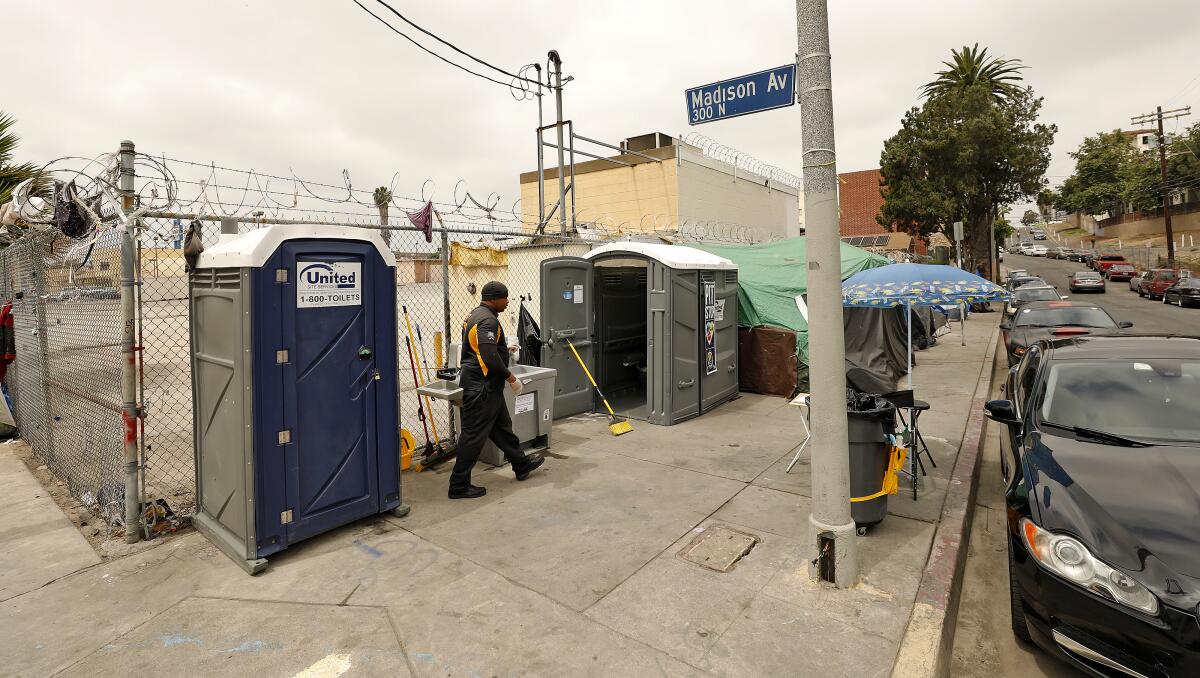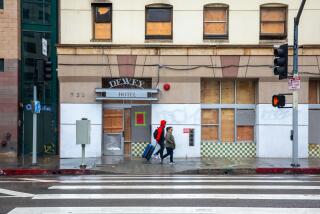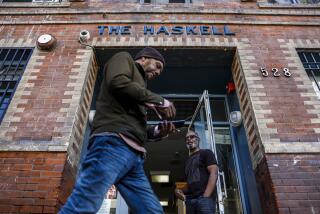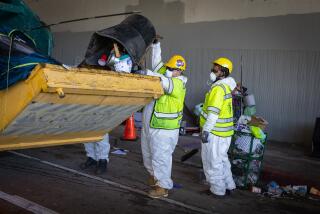Editorial: L.A. shouldn’t remove portable toilets from homeless encampments

Homeless people need shelter and housing, but they also desperately need public toilets. Without access to them, the unhoused have no choice but to carry out their most necessary and private of bodily functions on public streets and sidewalks. That’s a miserable situation for everyone.
Yet for years the city has failed to figure out how to provide an adequate number of public toilets. A 2017 study of bathroom availability found that the number of toilets available to 1,800 homeless people on skid row at night — nine — was fewer than the United Nations High Commissioner for Refugees’ standard of one toilet for every 20 people in a refugee camp. After the study, the city set up a number of staffed mobile bathrooms. They only fulfill a fraction of the need for the city’s 41,000 homeless individuals — some 29,000 of whom are unsheltered, living on the streets.
But as the pandemic began to engulf Los Angeles last year and public health officials feared that the coronavirus could decimate the unhoused population, the city finally set up facilities in massive numbers. The city rushed to put out 363 hand-washing stations and 182 portable toilets at encampments across the city. So many units were ordered that the city exhausted one vendor’s supply and had to go to another. For nearly a year and a half, the city has kept them in place and contracted for them to be serviced every day.
Now, the city is yanking all of them out. That’s a bad idea.
According to officials, the toilets are regularly broken, covered in graffiti and used for drug deals and prostitution. Hand-washing stations have been damaged, and soap and paper towels have been taken. City officials say they had to replace 175 toilets and 94 hand-washing stations.
Of course, it’s disturbing that the toilets were trashed. But they were also used for their intended function. And city officials don’t know for sure that soap and towels were pilfered. Maybe a lot of people washed their hands. Officials also believe that one vendor did not service the toilets and hand-washing stations every day as had been expected. Maybe if that had happened, the restrooms would have been in somewhat better shape.
The city insists that these installations were only intended to stay in place during the height of the pandemic as a public health measure. But COVID-19 is still a danger to the homeless population. Just a third of L.A. County’s estimated 66,000 homeless individuals are fully vaccinated. And even if the pandemic were over, why not keep toilet facilities in place? The need for them won’t go away after the pandemic.
City officials would like to use mobile pit stops that consist of one or two toilets with hand-washing sinks, all staffed by attendants. That means less damage and illicit use, but it also means more expense. The city is already paying $7 million a year on pit-stop restrooms at 19 locations. By contrast, it has cost about $4 million to operate hundreds of portable toilets and hand-washing stations since March 2020. So, officials say they couldn’t afford to put pit-stop units at every encampment that lost portable toilets.
And that’s just a potential plan. Any proposal will have to go through the City Council’s Homelessness and Poverty Committee and then the full council. All this could take weeks, if not months, to figure out. Think homeless people can hold it that long? Could you?
We get it. Bathrooms are complicated. They get vandalized. What the city doesn’t seem to get is how urgently they are needed. Apparently residents have complained about the porta-potties near encampments — as if the sight of them signals that the city has normalized the existence of homeless encampments. Not at all. It signals that the city thinks it’s bad public health to normalize urinating and defecating on streets and sidewalks and in people’s yards. And that’s what happens when there isn’t enough housing and shelter and when there aren’t enough public bathrooms.
So the city should come up with other plans fast. Why not use sturdier automated public toilets but without the costly attendants? During the past year, the city paid for several YMCA branches to open their doors during certain hours to provide bathroom facilities to homeless individuals. The city wants to continue that. Officials should also look to other community centers or businesses or houses of worship that could make their bathroom facilities available during certain hours, especially at night.
What will not work is believing that somehow homeless people either don’t need bathrooms as regularly as the rest of us do or that they will all go to group shelters at night. The latest inventory of shelter bed capacity in the entire county is a little less than 25,000. That’s not enough room just for the 41,000 homeless people in the city alone.
Meanwhile, there are still some portable toilets and hand-washing stations that have yet to be pulled from encampments. Just let them stay there — until the city actually comes up with another viable plan for how to get people to a bathroom.
More to Read
A cure for the common opinion
Get thought-provoking perspectives with our weekly newsletter.
You may occasionally receive promotional content from the Los Angeles Times.






